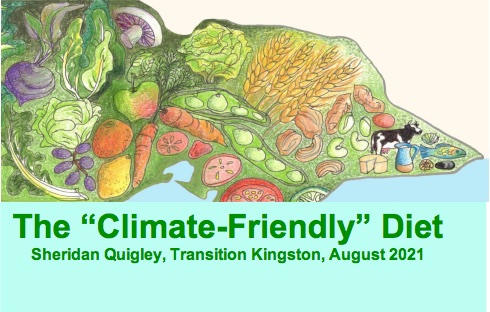The “Climate-Friendly” Diet
Once upon a time… we ate what was grown, farmed, or fished for, locally. This meant it was in season and we probably knew where it came from … but now……
We are all regularly exposed to emerging information about how the way we eat affects our health and impacts the environment. Yet conflicting information is published by a wide array of interest groups ranging from the food production and processing industries (and their lobbyists) to environmental organisations, as well as the medical/nutritionist professions. I’m confused. We’re all confused. But I think we all want to do better by ourselves and our planet. What we need is authentic information that helps us to be more reflective and appropriate in our choices and actions.
In the last century, agricultural and food production technology, rapid transport and international free trade markets erupted. We now enjoy foods flown in from all over the world, with scarcely a thought. Our expectations of what we can eat have been radically altered (to say nothing of the vast arena of processed foods that have been engineered to tickle our taste buds despite the depleted nutritional value which results from producing food for minimal cost).
However, this enticing cornucopia of global foods is unsustainable. The cost to our personal health and the health of the planet is being systematically revealed by high quality research from authoritative sources. It is damaging our personal health in the form of chronic disease (heart disease, cancer, obesity, diabetes). It is damaging the environment at profound level: deforestation, soil degradation, fresh water supply depletion, as well as contamination by nitrates etc. In terms of their contribution to global heating, meat and dairy farming produce 60% of agricultural greenhouse gas (GHG) emissions, (as well taking up 83% of available farmland), to say nothing of the impact of international transport delivering food around the world. Pertinently, reports published by the UN, WHO and WWF International in June 2020 indicate that deforestation and agricultural intensification are key drivers for diseases with future pandemic implications.
So, we need to change our eating habits.
In 2019 the EAT-Lancet Commission report, Food in the Anthropocene, set out the world’s first scientific targets for a universal “healthy planetary diet” – healthy for the planet and its humans. As a result of this and other on-going academic research into sustainability and food security, parameters of a ‘climate diet’ for Australia are being established. These are not complicated:
- Reduce meat and dairy consumption
- Eat more plant foods
- Avoid imported foods
- Avoid junk foods
In many respects, it’s largely a case of a return to the ‘once upon a time’, ie what is grown, farmed, or fished for, locally, in season and with a known provenance.
Reduce meat and dairy consumption
The ideal is to switch to a vegan diet. However, it is recognised that this is too radical a prospect for many people – Australians are the world’s second biggest meat eaters. But we should regard reducing consumption as an ethical imperative. An easy, immediate approach is to tweak the balance of our meals and recipes with the simple formula of ‘halve the meat, double the veg’. Also we can make more sustainable choices in our purchasing of animal products:
- organic meat, or meat with a traceable provenance, rather than factory farmed
- ‘wild’ meat, such as kangaroo, non-farmed rabbit, emu, crocodile
- well-informed selection of fish and seafood, guided by reputable sources such as the GoodFish: Sustainable Seafood Guide, maintained by the Marine Conservancy Council.
A surprise for vegetarians will be the finding by well-publicised international research, that diets which include animal products (of any kind) for only one meal per day are less GHG-intensive than typical lacto-ovo vegetarian diets.
Eat more plant foods
We are lucky in Australia to have a variety of climate regions enabling us to grow the most astonishing variety of vegetables and fruits within our own shores. This good fortune should encourage us to experiment much more with our cookery – taking inspiration from the plant-based food cultures around the world that use beans, lentils and nuts as their source of protein.
We also have fabulous array of native edible plants and herbs that have evolved to thrive in our climate, such as bush tomatoes, desert limes, kakadu plums, quandong and lemon myrtle. Interest in commercial growing of native foods is emerging, but this will only develop as a result of consumer demand.
Avoid imported foods
Politically and economically, the global marketplace for foods is a complex mix of advantages and disadvantages, but the negative environmental impact of its transportation is glaringly obvious. On a personal level, the main reasons we buy imported produce are either because it’s cheaper or because a home-grown product is not available right now. Both of these reasons can be signifiers of wider issues: cheap often means lack of regulation of labour and environment – prompting us to question the wider impact of throwing another Vietnamese prawn on the barbie. The purchase of cheaper imported produce also discourages Australian farmers from growing their own. Lack of availability should make us ask, do I need it now? Can I wait until it’s in season? Or even, do I need it all?
Avoid junk food
Enough said?
By Sheridan Quigley, Transition Kingston, August 2021
Artwork by Sheridan Quigley
— follow us on Transition Kingston 
—————————————————-
Bibliography
# Willett, W 2019, ‘Food in the Anthropocene: the EAT-Lancet Commission on healthy diets from sustainable food systems’. The Lancet Commissions vol 393, no 10170, pp.447-492.
DOI:https://doi.org/10.1016/S0140-6736(18)31788-4
# Parletta N. ‘What would a ‘climate diet’ look like in Australia?’ The Guardian 29.10.2019
<https://www.theguardian.com/food/2019/oct/29/what-would-a-climate-diet-look-like-in-australia>
# Carrington D. ‘Pandemics result from destruction of nature, say UN and WHO.’ The Guardian 17.06.2020 <https://www.theguardian.com/world/2020/jun/17/pandemics-destruction-nature-un-who-legislation-trade-green-recovery>
# Poore, J and Nemecek, T 2018 University of Oxford. ‘Reducing food’s environmental impacts through producers and consumers’. Science vol 360, no 6392, pp. 987-992
# Kim, B F 2020, ‘Country-specific dietary shifts to mitigate climate and water crises.’ Global Environmental Change vol 62. DOI: <https://doi.org/10.101016/j.gloenvcha.2019.05.010>
# Hadjikakou, M 2018 ‘Sustainable shopping: want to eat healthy? Try an eco-friendly diet.’ The Conversation 19.01.2018 <https://the conversation.com/sustainable-shopping-want-eat-healthy-try-an-eco-friendly-diet-89086>
# Australian Native Food and Botanicals (ANFAB). National body.
<https://anfab.org.au/main.asp?_=Home>
# Lowe, A 2019 ‘The Australian plants that could become our daily fare.’ Financial Review 25.01.2019
<https://www.afr.com/life-and-luxury/food-and-wine/the-aussie-plants-that-could-become-our-daily-fare-20181204-h18oom>
Tom Danby, Moonee Valley Sustainability, 2021

